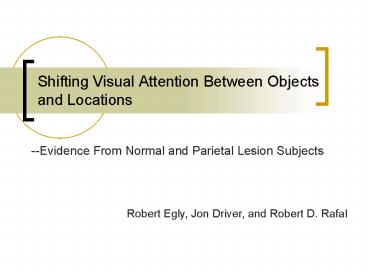Shifting Visual Attention Between Objects and Locations - PowerPoint PPT Presentation
1 / 22
Title:
Shifting Visual Attention Between Objects and Locations
Description:
Neuropsychological evidence. Farah, Wallace, Brunn, and Madigan (1989) ... Experiment 2 was to examine neuropsychological deficits in both the space- and ... – PowerPoint PPT presentation
Number of Views:156
Avg rating:3.0/5.0
Title: Shifting Visual Attention Between Objects and Locations
1
Shifting Visual Attention Between Objects and
Locations
- --Evidence From Normal and Parietal Lesion
Subjects
Robert Egly, Jon Driver, and Robert D. Rafal
2
Introduce
- The dispute between space-based and object-based
models of visual attention - Space-based
- object-based
3
Previous Evidence for Space-Based Attention 1
- The cuing paradigm
- Cue allows orienting mechanisms to allocate
resources to the cued locus. - Visual attention can operate on a purely spatial
representation of the visual field. - Accommodate spatial cuing effects within
object-based frameworks. - Tipper, Driver, and Weaver (1991)Object-centred
inhibition of return
4
Previous Evidence for Space-Based Attention 2
- The spatial nature of attention deficits after
brain damage appears broadly consistent with
space-based models. - Unilateral neglect
- Neglect can result from damage to a number of
distinct components in a network controlling.
(Posner et al.) - Disengage ?unilateral parietal lobe
- Move ? midbrain retinotectal pathway
- Engage ?pulvinar nucleus of the thalamus
5
Previous Evidence for Object-Based Attention 1
- Duncan (1984)?
- Watt (1988)
- Duncans results might therefore imply
spatial-frequency restrictions on attention
rather than object-based restrictions. - Baylis and Driver (1993)
- Kramer and Jacobson (1991)
6
Previous Evidence for Object-Based Attention 2
- Neuropsychological evidence
- Farah, Wallace, Brunn, and Madigan (1989)
- Patients with bilateral lesions of the parietal
lobes (simultaneous agnosia)
LNOA
GHDF
7
Summary
- The experiment was designed to measure both
space-based and object-based components of covert
visual orienting within a single task. - The purpose of Experiment 1 was to examine how
cuing one part of an object affects the
processing of other parts of that object and
equidistant parts from another object. - The purpose of Experiment 2 was to examine
neuropsychological deficits in both the space-
and object-based components of visual attention.
8
Experiment 1 1
- The subjects task was to detect the emergence of
the target - Design
- Target-present trials (640)
- 75 valid cue(480), 25 invalid cue(160)
- Catch trials (128)
- Result
- Initial analysis
- Three-way within-subjects ANOVA
- cuing (valid or invalid), target field
(left or right), orientation of rectangles
(vertical or horizontal) - Cuing effect analysis ?
- Three-way within-subjects ANOVA
- rectangle (cued or uncued), target field
(left or right), direction of the required shift
in attention (vertical or horizontal)
9
Experiment 1 2
- Discussion
- Purely spatial component ?attention shift to a
new locus - Object-based component ?additional cost of
between-objects shifts - The between-objects cost cannot be attributed to
any difficult in moving attention across
contours.
10
Experiment 2 1
- Procedure and design were identical to those of
Experiment 1 - Patients with unilateral damage to parietal
cortex - Having a pathological spatial disengage operation
- Detection should be abnormally slow for
contralesional targets after an invalid cue. - Evidence for spatial component ( a disengage role
for the parietal lobe) - Invalidly cued target in contralesional versus
ipsilesional - Evidence for non-spatial component
- Additional cost for between versus within object
shift
11
Experiment 2 2
- Subject ?
- Result
- Initial analysis
- four-way mixed ANOVA
- cuing (valid or invalid), target field
(ipsilesional or contralesional), orientation of
rectangles (vertical or horizontal) - side of lesion (left or right) ?
- Cuing effect analysis
- Three-way within-subjects ANOVA
- rectangle (cued or uncued), target field
(ipsilesional or contralesional), direction of
the required shift in attention (vertical or
horizontal)
interaction
interaction
12
Experiment 2 3
- A signifisant three-way interaction among side of
lesion, target field, and cued versus uncued
rectangle. - Right-lesion
- There were significant effects of both field and
rectangle but no interaction. - Left-lesion
- Interaction between target field and cued versus
uncued rectangle.
13
General Discussion
- Right-parietal damage appears to impair only the
space-based component, whereas left-parietal
damage appears to impair both the space-based and
object-based components. - The left hemisphere is relatively specialized for
shifting attention between objects compared with
the right hemisphere.
14
Inhibition of return
Attention might apply to the cued box rather than
to the cued location per se, because the delayed
inhibitory effects of peripheral cues could
follow the cued box when it moved to a new
location.
15
Duncan (1984) Baylis and Driver (1993)
16
Stimuli and procedure
Wait for response
1000ms
100ms
200ms
17
Result of experiment 1
The additional cost must reflect a time cost for
shifting attention between objects ?object-based
component
18
Cilnical Date for patients
19
(No Transcript)
20
(No Transcript)
21
(No Transcript)
22
The difference between the contralesional and
ipsilesional object effects
Object effect (uncued rectangle invalid-cue
RT)-(cued rectangle invalid-cue RT)































